The plus-size clothing industry really sucks. It has gotten much better than it used to be, but for the most part it leaves something to be desired. I have been plus size my whole life, but I still like clothes and I like to look nice every now and then. However, it is tough dealing with an industry that doesn’t want you to wear nice clothes without paying an arm and a leg for it. The only alternative is clothes that are horrifically ugly.
Historically, people have always been bigger than the “average size” that is advertised in clothing stores. In fact, according to Julia Felsenthal of Slate and The Washington Post, women’s clothing sizes were created when the American government tried to define the “Average American Woman” in the 1950’s. They sent a pair of statisticians to survey and measure nearly 15,000 women. They “hoped to determine whether any proportional relationships existed among measurements that could be broadly applied to create a simple, standardized system of sizing.”
As one might guess, this did not work. A measurement of 15,000 women cannot standardize all women. Surprisingly, there were more than 15,000 women in America during that time. That was a bit of sarcasm, but what is truly surprising is that the clothing industry still uses those numbers to manufacture fashion.
This affects the plus-size clothing industry because women’s bodies are still being held to that same standard as in the 1950s. The Washington Post notes that a “size 8 dress today is nearly the equivalent of a size 16 dress in 1958. And a size 8 dress of 1958 doesn’t even have a modern-day equivalent — the waist and bust measurements of a Mad Men-era 8 come in smaller than today’s size 00.”
A simple Google search will tell you the average dress size for a woman in the last 5-10 years is a size 16. However, if you walk down to your local plus-size section in any store, there are only about 4 or 5 of those sizes and dozens more when it comes to a size 6.
It is a rigged industry. Not only this but the same size 16 at one store is not the same at another store in the same mall.
Personally, I fit about a size 16 at Old Navy or Forever 21, but at H&M I am about a size 20 or 22. The internalized fatphobia that I feel when I see that hurts me, but it’s not me or my body; very little has changed.
I am not the only person who struggles with this, plus-size actress Rebel Wilson told StyleCaster that she feels “gross or excluded or like fashion isn’t for you.” Before the plus-size industry expanded she needed to wear men’s clothing. The industry has a serious problem with catering to plus-size women.
(Eva Rinaldi/WIKIMEDIA)
There is also a pricing issue for people who fit plus-size clothing. There are tunics in Old Navy that are $19.94 for “regular size” people but the same tunic costs $29.94, for someone who is plus size. That’s a $10 jump.
You could argue that it costs more because the company spends more to make it. To debunk that $13 increase for a plus-size person, just go into a craft store and do some math, that will tell you. To humour those who still believe that there is good reason for the price shift, the question is this: why is it so much more? If it cost about $5 more fine, but $10 is a lot for some extra wool; and that’s if the company is fairly paying the manufacturers – another topic for another day.
It is inexcusable that plus-size people have to pay much more for the same item, or as Rebel Wilson said, are forced into wearing the only outfit that fits and is very unflattering on you.
We can finish this as it began; the plus-size clothing industry totally sucks. But it doesn’t have to. The best thing the industry can do, or more specifically what designers and advertisers can do, is talk to plus-size people! It seems that everyone tells plus-size people what they want and what they need, but no one is asking. How about a more recent statistic on the average size of a woman? Why not bring a larger supply of bigger sizes into your stores?
Stop with the BS that plus-size people are bothersome and need so much more work and effort than straight sizes do. All the industry has to do is ask. I have a fat butt and a fatter mind, and I can use it to answer questions and make decisions for myself. Just ask. It’s that simple.


